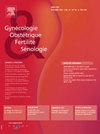[玻璃化囊胚移植后的临床结果与冷冻适应症的关系]。
IF 0.6
4区 医学
Q4 OBSTETRICS & GYNECOLOGY
引用次数: 0
摘要
目的:在法国,除人工授精外,胚胎解冻占辅助生殖技术尝试的 45.8%。由于各种原因,这一比例在不断上升。本研究的主要目的是根据冷冻囊胚移植(FBT)的最初适应症,比较冷冻囊胚移植后的活产率:这是一项回顾性研究,包括 2020 年 1 月 1 日至 2022 年 6 月 30 日期间在图尔地区大学医院中心接受冷冻囊胚移植手术的患者。对三种主要冷冻适应症的结果进行了比较(单变量和多变量分析):因卵巢过度刺激(=OHS)风险而冷冻完整的囊胚群、冷冻新鲜囊胚移植(BT)后妊娠(=第二次要求)或未妊娠(=BT失败)的超数囊胚。结果:结果:在选定的 963 个 FBT 周期中,通过解冻获得活产的比例为 28%,所有冷冻适应症合并计算。与OHS组相比,FBT失败组的比例明显较低。然而,经过调整后,与冷冻周期中患者的年龄有关的结果仍然显著,但与冷冻适应症无关:考虑到各种混杂因素,冷冻适应症似乎对冷冻治疗的结果影响不大。有必要对一项多中心研究的更多数据进行前瞻性分析,以证实这些结果。本文章由计算机程序翻译,如有差异,请以英文原文为准。
Devenir clinique après transfert de blastocystes vitrifiés selon l’indication de congélation
Objectives
In France, embryo thawing concern 45.8% of attempts at assisted reproductive technologies excluding artificial inseminations. This proportion is constantly increasing for various reasons. The main objective of this study is to compare the live birth rate following frozen blastocyst transfer (FBT) according to the initial indication for freezing.
Methods
This is a retrospective study including patients who underwent FBT between 01/01/2020 and 06/30/2022 at the Regional University Hospital Center of Tours. The results were compared (univariate and multivariate analyses) between the three main indications for freezing: freezing of the complete cohort of blastocysts for risk of ovarian hyperstimulation (=OHS), freezing of supernumerary blastocysts after fresh blastocyst transfer (BT) with pregnancy (=second request) or without pregnancy (=BT failure). Results have also been described for other indications.
Results
Among the 963 FBT cycles selected, 28% of live births by thawing were obtained, all indications of freezing combined. A significantly lower rate was identified in the FBT failure group compared to the OHS group. However, after adjustment, the results remained significant for the age of the patient on the freezing cycle but not for the indication for freezing.
Conclusions
The outcome of a FBT does not seem significantly impacted by the indication of freezing considering the confounding factors. The prospective analysis of more data from a multicenter study would be necessary to confirm these results.
求助全文
通过发布文献求助,成功后即可免费获取论文全文。
去求助
来源期刊

Gynecologie Obstetrique Fertilite & Senologie
Medicine-Obstetrics and Gynecology
CiteScore
1.70
自引率
0.00%
发文量
170
期刊介绍:
Gynécologie Obstétrique Fertilité & Sénologie est un mensuel scientifique d''information et de formation destiné aux gynécologues, aux obstétriciens, aux sénologues et aux biologistes de la reproduction. La revue, dans ses éditoriaux, articles originaux, mises au point, lettres à la rédaction et autres rubriques, donne une information actualisée ayant trait à l''obstétrique et à la gynécologie et aux différentes spécialités développées à partir de ces deux pôles : médecine de la reproduction, médecine maternelle et fœtale, périnatalité, endocrinologie, chirurgie gynécologique, cancérologie pelvienne, sénologie, sexualité, psychosomatique…
 求助内容:
求助内容: 应助结果提醒方式:
应助结果提醒方式:


